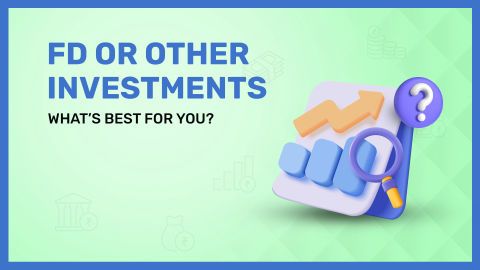If you have ever struggled to actively manage your equity investments or found the stock market overwhelming, you’re not alone. Building a good portfolio is one thing but tracking it regularly, making timely adjustments, and managing risks takes time, skill, and experience. That’s where Portfolio Management Services (PMS) come into play.
PMS is a professional service where qualified experts manage your investments on your behalf. From research to portfolio construction and real-time adjustments, they handle it all. Think of it like hiring a financial specialist who understands the markets deeply and aligns your portfolio with your long-term financial goals. If you’re exploring advanced investment options but want flexibility and professional support, consider mutual funds as an accessible starting point.
Compare Mutual Fund Options Now
This article will break down everything you need to know about PMS—including what it means, how it works, the different types, and why it’s gaining popularity among serious investors.
What is a Portfolio Management Service (PMS)?
Portfolio Management Services (PMS) are personalised investment solutions managed by professional portfolio managers. Unlike mutual funds that pool money from many investors into a common strategy, PMS is tailored to suit your specific financial goals.
Here, portfolio managers build and actively manage a mix of investments based on your risk appetite, investment horizon, and expected returns. Whether you're focused on aggressive growth or wealth preservation, they create a strategy that fits your needs. These services are ideal for High-Net-Worth Individuals (HNIs) because they account for liquidity preferences, tax treatment, and risk levels.
And yes, PMS is regulated. Only SEBI-registered entities can offer it, which adds a level of safety and accountability. Also, the minimum investment amount has evolved over time—it now stands at Rs. 50 lakh, signalling the premium nature of this service. If your current investments are under Rs. 50 lakh diversified mutual funds could offer similar professional management with a lower entry barrier. Start Investing with Rs. 100
How do portfolio management services work?
Think of PMS as a custom-built investment account where your money is handled by a dedicated professional. When you opt for PMS, your portfolio manager starts by understanding your financial goals, risk tolerance, and investment duration.
They then build a portfolio just for you—typically a mix of stocks, debt instruments, and sometimes alternative assets. The idea is to balance returns and risks in a way that works for you. Unlike mutual funds, where the strategy is fixed, PMS is customised, flexible, and actively managed.
Here are a few important things to note:
Minimum investment is Rs. 50 lakh.
Fees are higher than mutual funds—expect around 2–2.5% annually.
Performance isn’t guaranteed, but the service is tailored and dynamic.
Types of portfolio management services in India
Portfolio Management Services come in a few flavours. Broadly, they are classified based on how active the manager is and how much control the investor retains.
A. Active portfolio management
Here, the manager keeps a close eye on the markets and tweaks your portfolio frequently to outperform benchmarks. It’s hands-on, high-effort, and aimed at maximising gains—but also comes with higher costs and risk.
B. Passive portfolio management
This approach follows a predefined strategy, often mirroring an index. It involves minimal changes and lower fees, but returns usually match the market, not beat it.
There’s also another way to classify PMS based on control:
Discretionary PMS: Your portfolio manager takes all decisions independently.
Non-discretionary PMS: The manager advises; you make the final call on every investment.
If you're unsure which management style suits your goals, mutual funds allow you to experience both passive and active strategies at scale and with lower commitment. Compare Mutual Fund Options Now
Objectives of portfolio management
The primary goal of portfolio management is to help you grow your wealth while keeping risks in check. But it’s more than just chasing returns—it’s about building an investment plan that fits your life.
Here is what portfolio management aims to do:
Achieve your financial goals by delivering the returns you expect within a realistic timeframe.
Manage risk smartly by aligning investments with how much market ups and downs you’re comfortable with.
Balance your investments across different assets so that your money isn’t overly dependent on just one type of security.
Match your liquidity needs and tax planning, ensuring you have access to funds when needed and that taxes don’t eat into your profits unnecessarily.
Key elements of portfolio management
Building and maintaining a portfolio isn’t just about picking the right stocks. It’s a systematic process that includes a few core strategies. Let’s break them down:
1. Asset allocation
This involves deciding how much money to invest across various asset types like stocks, bonds, gold, and real estate. It ensures that poor performance in one area doesn’t sink your entire portfolio.
2. Diversification
This means spreading your money across different industries, sectors, and companies—even within the same asset class. The goal? To lower the impact of any single investment going wrong.
3. Rebalancing
Over time, some investments will grow faster than others, throwing your original asset mix out of sync. Rebalancing is the process of adjusting your portfolio periodically to bring it back in line with your strategy. Together, these elements create a structure that adapts to changing markets without losing sight of your goals.
If you're new to these techniques, mutual funds implement them automatically making it easier to benefit from professional-level strategies without deep market involvement. Explore Top-Performing Mutual Funds
Portfolio management process
Now that you know the goals and key strategies, here’s how the actual portfolio management process unfolds step-by-step:
Step 1: Define your investment profile—this includes understanding your goals, how much risk you can take, and any specific needs or preferences you have.
Step 2: Review your existing investments (if any) and assess their performance, strengths, and gaps.
Step 3: Based on the insights, your portfolio manager creates a customised strategy that includes a recommended mix of assets.
Step 4: Once the plan is ready, they start buying and selling securities to build your portfolio.
Step 5: The portfolio is monitored regularly to track performance, manage risk, and respond to market movements.
Step 6: Your portfolio’s results are compared with your original goals to ensure it’s on track.
Step 7: If necessary, the portfolio is revised—allocations are adjusted, assets are rebalanced, and changes are made to stay aligned with your needs.
Benefits of investing in portfolio management services
Choosing Portfolio Management Services (PMS) can offer several advantages, especially if you’re looking for more than just a cookie-cutter investment solution.
Customisation
One of the biggest benefits of PMS is how personalised it is. You don’t just invest in a ready-made plan—you get a portfolio tailored to your risk appetite, goals, and preferences. You can also choose specific themes or styles that match your values or financial interests.Expertise
PMS comes with the support of professional portfolio managers and research teams who understand markets deeply. Their experience helps in navigating market ups and downs, making smart decisions for your money. However, if you want similar benefits without the high entry barrier, mutual funds offer expert-driven diversification and regular reporting even at low ticket sizes. Compare Mutual Fund Options NowTransparency
You get regular updates and performance reports on your portfolio. Many PMS providers also offer online access so you can track your investments in real time and know exactly where your money is going.Flexibility
With PMS, you can hand over the investment decisions to experts while still staying informed. It’s ideal for investors who want involvement without micromanagement. You can also switch strategies or managers if your needs change.Cost considerations
Understanding the costs is crucial. PMS typically involves management and performance-based fees. Knowing what you’re paying helps you evaluate the value you’re getting.Dynamic portfolio rebalancing
PMS providers proactively adjust your investments based on market conditions or changes in your financial life. This keeps your portfolio aligned with your goals.Real-time access
Many PMS platforms now offer digital dashboards where you can check performance, holdings, and market updates instantly.Regulatory compliance
PMS providers are governed by SEBI, which ensures fair practices, ethical conduct, and investor protection. It builds trust in the system and keeps your investment journey secure.
Why should you opt for portfolio management services?
If you're someone who wants your investments to be managed with precision and care—but without having to track markets daily—PMS could be a great fit.
With PMS, you get tailor-made investment strategies that reflect your financial goals, time horizon, and risk appetite. Instead of managing your portfolio alone, you get a team of professionals who do the heavy lifting for you—from research to real-time adjustments.
PMS also ensures that your money is allocated in the most effective way, while giving you tools to monitor progress anytime. Plus, with strong regulatory backing, you can invest with more confidence and peace of mind.
Whether you're planning for retirement, growing wealth for the future, or simply want expert guidance, PMS offers a structured path to long-term financial success.
Suitability of PMS
Portfolio Management Services aren’t for everyone—but they’re ideal for those looking for a more advanced and tailored approach to investing.
1. High net worth individuals (HNIs)
If you have Rs. 25 lakh or more to invest, PMS opens the door to diversified and professionally managed portfolios designed for serious wealth creation.
2. Long-term investors
PMS works best for people with a long-term view. It allows investments to grow steadily under expert supervision, riding out short-term market ups and downs.
3. Busy professionals
If you don’t have the time or expertise to manage your investments, PMS is a convenient way to delegate the task while still maintaining control.
4. Those seeking customisation
PMS portfolios aren’t one-size-fits-all. Whether you want high growth, capital protection, or tax efficiency, your portfolio can be structured accordingly.
5. Investors focused on risk management
If managing risk is a priority for you, PMS offers proactive rebalancing and strategy updates that can adapt as markets shift.
If you do not meet the PMS threshold, mutual funds can still offer diversified exposure, professional management, and strategic asset allocation even with modest amounts. Open Your Mutual Fund Account
What features to look for in a PMS?
When choosing a Portfolio Management Service, it’s important to look beyond the name and focus on the features that really impact your money. Here's what to check:
Model portfolio
Most PMS providers present a model portfolio while pitching their services. This is a sample of how they usually invest. Look at its past performance and see how it stacks up against market benchmarks. It can give you a sense of their decision-making and investment philosophy.Portfolio manager expertise
Your portfolio’s success depends a lot on the person managing it. Find out about the portfolio manager’s background, qualifications, experience, and track record. Have they consistently delivered returns? Are they known for strong risk management?Investment strategy
Every PMS has its own way of investing—some are aggressive, others are conservative. Make sure you understand the strategy and feel confident about how it plans to grow your money. A transparent explanation shows credibility.Fee structure
Check how the charges are set up. Most PMS models involve a combination of fixed management fees and performance-linked fees. A hurdle rate (a minimum return that must be achieved before fees apply) ensures you only pay for results, not just activity.Customer support and transparency
Timely updates, clear reports, and strong communication can make your PMS experience smoother. Discretionary PMS investors especially value openness in performance reviews and easy access to their portfolio status.
What are the PMS charges in India?
When investing in PMS, it’s essential to know what you’ll be paying for. These charges can impact your returns, so understanding them upfront helps you evaluate whether the service is worth it.
Entry load
Some PMS providers charge an initial fee when you start investing—this is called the entry load. It usually hovers around 3% but may vary by provider.Management charges
You’ll also pay quarterly management fees for handling your portfolio. This can range between 1% and 3% annually, depending on the firm’s pricing model.Profit-sharing fees
Some PMS providers have a profit-sharing arrangement. This means they only earn an additional fee when your returns cross a pre-decided benchmark or “hurdle rate.” This aligns their incentives with your success.Other charges
Apart from the main fees, you might also be charged for things like:
Custodian fees: For holding your assets
Demat account opening charges
Audit fees
Transaction brokerage
For investors looking for a more cost-effective and transparent fee structure, mutual funds offer well-regulated options with lower expense ratios. Explore Cost-Efficient Mutual Funds
Conclusion
Portfolio Management Services offer a powerful way to grow and protect your wealth—but they aren’t for everyone. If you’re looking for a personalised investment approach, guided by experts who understand markets, PMS can give you that edge. The benefits customisation, professional management, transparency, and flexibility can outweigh the costs, especially if you have the investment capital and a long-term vision.




